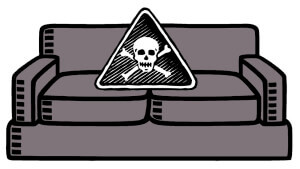GSP responds to ACC statement
December 31, 2012
The American Chemistry Council (ACC) is a trade organization which represents numerous companies including Albemarle, Chemtura, and ICL North America, the three largest manufacturers of halogenated flame retardants. According to their website, the ACC’s mission is to:
“…deliver business value through exceptional advocacy using best-in-class member performance, political engagement, communications and scientific research.”
In response to our recent study revealing that 85% of couches tested contained toxic or potentially harmful flame retardants, the ACC made the following statements, which we have responded to below. (Read our blog post about the couch study here.)

Our study found that 41% of couches contained chlorinated Tris (TDCPP), the cancer-causing chemical removed from baby pajamas in the 70’s.
Anne Kolton of the ACC responded on CBS This Morning:
TDCPP was removed from children’s pajamas by industry voluntarily in response to consumer concern and consumer demand in an abundance of caution. There was no regulatory finding or scientific finding related to TDCPP.
Our response: There were scientific findings on TDCPP which prompted its removal from children’s pajamas, referenced in our paper. Research by Dr. Blum published in the journal Science May 19, 1978 found that TDCPP is a mutagen (it changes DNA). You can read the abstract of the paper in PubMed here or download the paper here.
A written statement from the ACC:
This study confirms what we would expect to find: Furniture manufacturers use flame retardants to meet established fire safety standards, which help save lives. There is no data in this study that indicate that the levels of flame retardants found would cause any human health problems.
Our response: We specifically reference data from the Consumer Product Safety Commission (CSPC) indicating that people may be exposed to unsafe levels of TDCPP from furniture: “Our current study suggests that…a large percentage of the population may have increased cancer risks due to exposure to TDCPP treated furniture, according to the CPSC model. (pg. 13438)” You can find that CPSC report here.
The ACC statement continues:
Statistics show that home fires from open flame ignition sources are still a significant problem.
Our response: Our paper is concerned with flame retardants as used in residential furniture foam. According to a recent report from the National Fire Protection Association, smoking materials continue to be the leading cause of furniture fires, causing on average 291 deaths per year in the US (Table 17, pg. 35). In contrast, there were on average 57 deaths per year from unintentional fires started by a small open flame ignition source (candles, lighters or matches) on upholstered furniture (Table 22, pg. 38). This data identifies smoking materials as the more significant problem.
Flame retardants can be an effective way to meet fire safety standards, and are designed to prevent fires from starting and if a fire does occur, slow its spread and provide valuable escape time.
Our response: We are focused on flame retardants as used in residential furniture foam. Both the CPSC and Underwriter’s Laboratories find that flame retardants as used in the foam of residential upholstered furniture do not provide a meaningful fire safety benefit. In a recent report, CPSC studied whether flame retardants in furniture foam reduced fire hazard and found that “…the fire-retardant foams did not offer a practically significantly greater level of open- flame safety than did the untreated foams. (pg. 26)”
Indeed, one recent analysis, using data from a National Institute of Justice arson study, showed flame retardants in upholstered furniture can provide valuable escape time.
Our response: An investigation by the Chicago Tribune casts serious doubt on the cited study. The Tribune found that this study is not peer-reviewed and based its conclusions on one piece of dubious data that was thrown out of the original National Institute of Justice arson study. Furthermore, the fabric tested is not used on furniture– it came from theatrical curtains that are designed to self-extinguish in the case of a fire. These numerous flaws led the Tribune to conclude that “…the new paper reaches unsupported conclusions and misleads the public, much like previous studies embraced by industry…”.
We are disappointed that the ACC did not read our study and its references more carefully before responding.